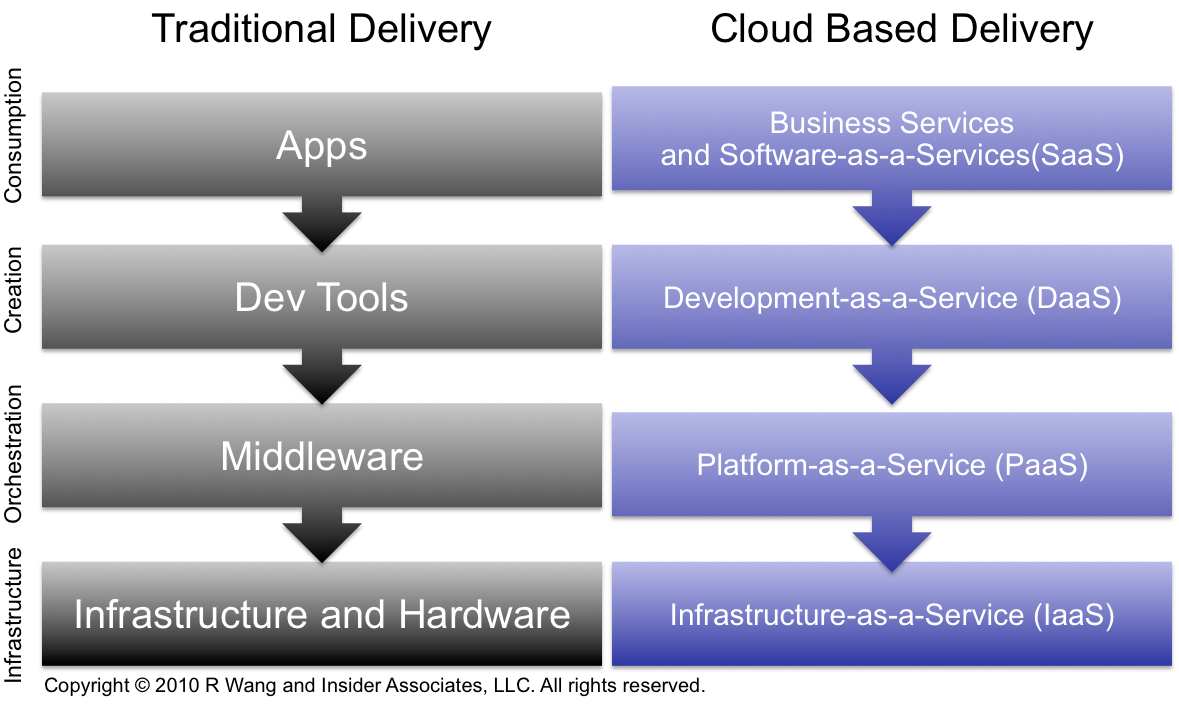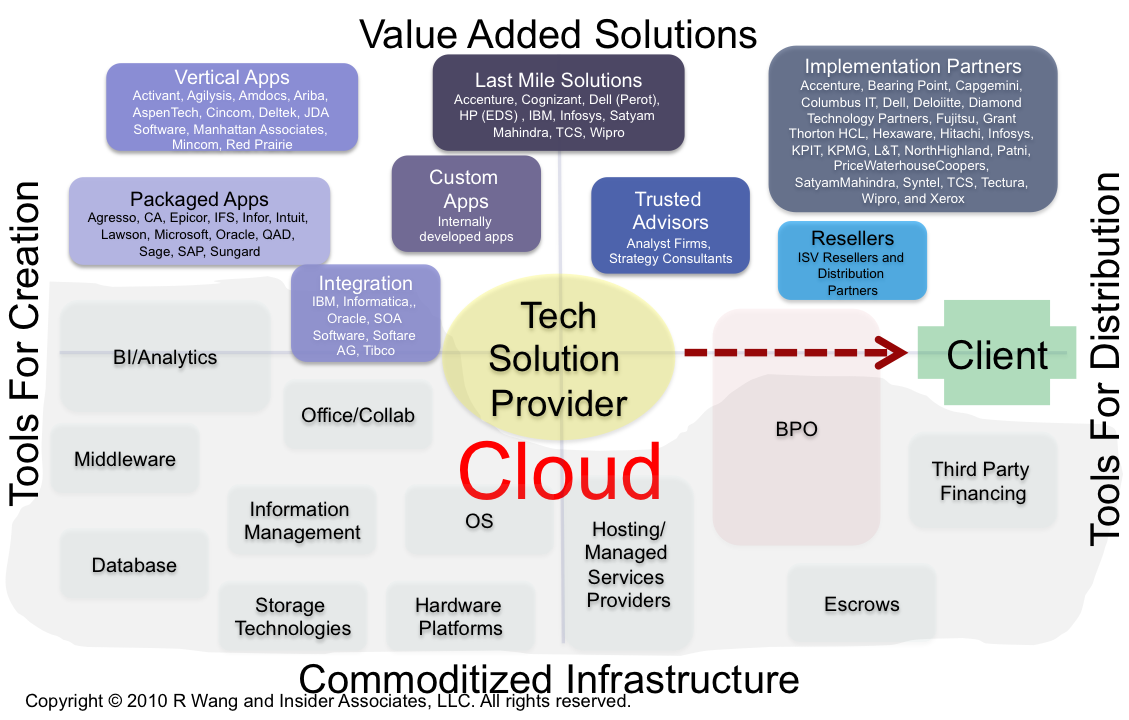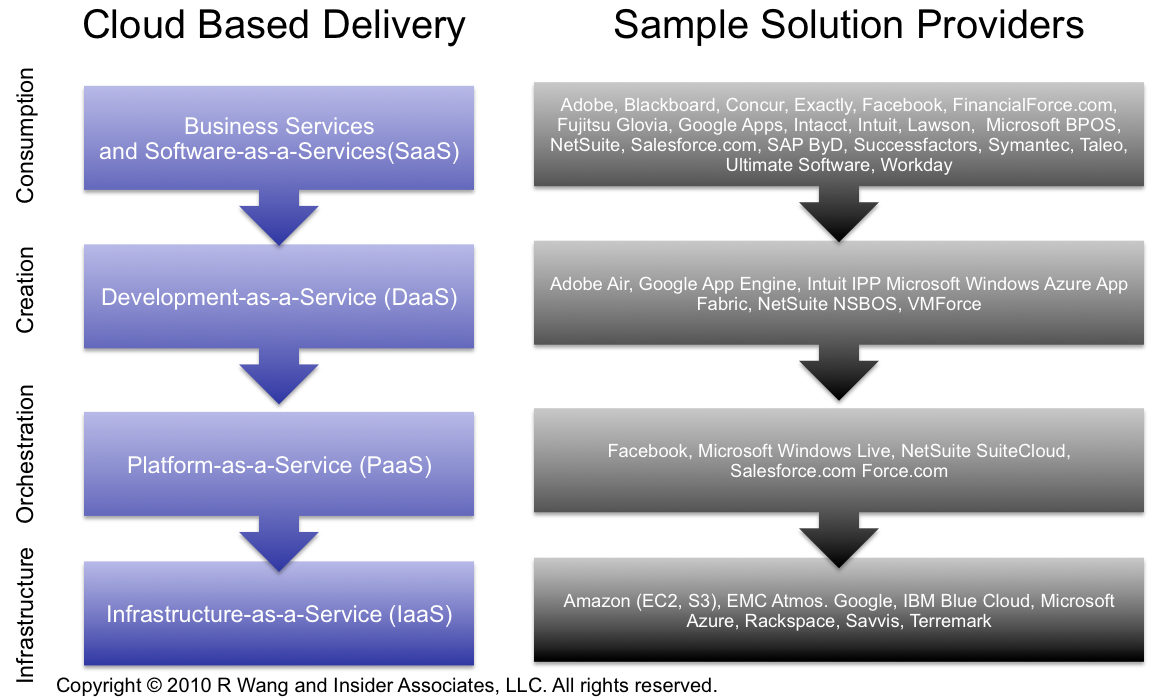Research Report: The Upcoming Battle For The Largest Share Of The Tech Budget (Part 2) - Cloud Computing
Welcome to a part 2 of a multi-part series on The Software Insider Tech Ecosystem Model. Part 2 describes how the cloud fits into the model. Subsequent posts will apply the model to these leading vendors:
The aggregation of these posts will result into a research report available for reprint rights.
Cloud Computing Represents The "New" Delivery Model For Internet Based IT Services
Technology veterans often observe that new mega trends emerge every decade. The market has evolved from mainframes (1970's); to mini computers (1980's); to client server (1990's); to internet based (2000's); and now to cloud computing (2010's). Many of the cloud computing trends do take users back to the mainframe days of time sharing (i.e. multi-tenancy) and service bureaus (i.e cloud based BPO). What's changed since 1970? Quite plenty -- users gain better usability, connectivity improves with the internet, storage continue to plummet, and performance increases in processing capability.
Cloud delivery models share a stack approach similar to traditional delivery. At the core, both deployment options share four types of properties (see Figure 1):
- Consumption – how users consume the apps and business processes
- Creation – what’s required to build apps and business processes
- Orchestration – how parts are integrated or pulled from an app server
- Infrastructure – where the core guts such as servers, storage, and networks reside
As the über category, Cloud Computing manifests in the four distinct layers of:
- Business Services and Software-as-a-Service (SaaS) – The traditional apps layer in the cloud includes software as a service apps, business services, and business processes on the server side.
- Development-as-a-Service (DaaS) – Development tools take shape in the cloud as shared community tools, web based dev tools, and mashup based services.
- Platform-as-a-Service (PaaS) – Middleware manifests in the cloud with app platforms, database, integration, and process orchestration.
- Infrastructure-as-a-Service (IaaS) – The physical world goes virtual with servers, networks, storage, and systems management in the cloud.
Figure 1. Traditional Delivery Compared To Cloud Delivery
Cloud Computing Encourages Users And Vendors To Focus On Value Added Solutions
Applying The Software Insider Tech Ecosystem Model to Cloud Computing highlights where buyers, sellers, and partners can deliver value (see Figure 2). As cloud computing adoption increases, users can expect that:
- Solution providers and partners will invest in value added solutions over commoditized infrastructure. The continued commoditization of technology results in richer and more relevant Cloud stacks. As a result, a handful of larger players will emerge to drive down the costs of computing while encouraging ecosystems to deliver value added solutions. Buyers can expect packaged apps, vertical apps, last mile solutions, and implementation partners, to invest in specialized and higher value intellectual property (IP).
- Customers will care more about service level agreements than the brand name of technology components. The cloud commoditizes the infrastructure components for both tools for creation and tools for distribution. Users shift their priority for brand components in favor of outcomes based delivery. Consequently, users will not care about the brand name of hardware, database, middleware, and even business intelligence systems in use. Client success shifts to the monitoring of pre-agreed upon service level agreements (SLA's)
- Integration will emerge as the key enabler and choke point. End users need an enterprise apps strategy for cloud computing that addresses the “I” word – Integration. SOA principles must be enforced including support for canonical data models and business process haromonization. Integration must focus on data mapping, business process orchestration, quality of service, and master data management.
Figure 2. The Software Insider Tech Ecosystem Model For The Cloud
The Bottom Line For Buyers - Use The Tech Ecosystem Model To Build Out Your Technology Roadmap And Procurement Strategy.
The Software Insider Tech Ecosystem Model can provide a key tool in mapping out the long term apps strategy. Use the suggested five step approach to determine how cloud computing can support existing and future business requirements:
- Start by listing the vendors in each category. Jot down the names of every vendor you own into each category (see Figure 3.)
- Identify the key business processes supported. Place business processes at the high level and line them back to the vendors.
- Evaluate the application portfolio. As consolidations occur, business strategy should align with applications strategy. Applications strategy will then align with procurement strategy to optimize the Business Technology Value equation.
- Build out your solution ecosystem plan. In some cases, you will consolidate vendors. In others, you will acquire new solutions. Sometimes, the last-mile will require custom development. Take a balanced approach to the portfolio. Keep in mind how you sunset legacy applications and solutions.
- Apply model to the contract strategy. This model applied to Seven Simple Steps To Successfully Negotiate Software Contracts will drive business value in technology projects.
Figure 3. Sample Solution Providers Across The Four Layers Of Cloud Computing
The Bottom Line For Sellers (Vendors) - Use The Tech Ecosystem Model To Plan Partnerships and M&A Strategies
Use the Software Insider Tech Ecosystem Model to determine when to partner, build, or acquire a capability. Determine which category to invest in Cloud Computing based on R&D budget and organization's size. Evaluate each category by:
- Examining the current footprint. Fill in the model to see what you own (see Figure 3).
- Identifying adjacent profit pools. Look at potential install base up-sell, cross-sell, and attach rate opportunities.
- Determining potential profit margins and ROI. Look at average profit margins. Identify and rank the top categories.
- Ranking opportunities by competitive threat. Determine which piece to commoditize next in the value added solutions. Figure out which areas are high growth value added solutions to invest.
- Put together 3 year strategy. Face it, 3 years is too long but you need a time frame. Identify acquisition prices and partnership criteria.
Your POV.
Buyers, do you need help with your Cloud and SaaS strategy? Ready to put the expertise of over 1000 software contract negotiations to work? Give us a call! Sellers and vendors, want to expedite your ability to effectively partner or test your M&A idea? You can post or send on to rwang0 at gmail dot com or r at softwaresinsider dot org and we’ll keep your anonymity.
Please let us know if you need help with your next gen apps strategy, overall apps strategy, and contract negotiations projects. Here’s how we can help:
- Designing a next gen apps strategy
- Providing contract negotiations and software licensing support
- Demystifying software licensing
- Assessing SaaS and cloud
- Evaluating Cloud integration strategies
- Assisting with legacy ERP migration
- Planning upgrades and migration
- Performing vendor selection
- Renegotiating maintenance
Resources And Related Research:
20100621 A Software Insider's POV - R "Ray" Wang - "Research Report: How SaaS Adoption Trends Show New Shifts In Technology Purchasing Power"
20100322 A Software Insider’s POV – R “Ray” Wang -”Understanding The Many Flavors Of Cloud Computing/SaaS”
20091222 A Software Insider’s POV – R “Ray” Wang “Tuesday’s Tip: 10 Cloud And SaaS Apps Strategies For 2010″
20091208 A Software Insider’s POV – R “Ray” Wang – “Tuesday’s Tip: 2010 Apps Strategies Should Start With Business Value”
20091012 A Software Insider’s POV – R “Ray” Wang – “Research Report: Customer Bill of Rights – Software-as-a Service”
20090714 Sandhill.com – R “Ray” Wang – “Opinion: Moving to a SaaS Offensive”
20090602 A Software Insider’s POV – R “Ray” Wang ” Tuesday’s Tip: Now’s The Time To Consider SaaS Software Escrows”
20081028 A Software Insider’s POV – R “Ray” Wang “Tuesday’s Tip: SaaS Integration Advice”
Next In The Series
Reprints
Reprints can be purchased through the Software Insider brand or Altimeter Group. To request official reprints in PDF format, please contact [email protected].
Disclosure
Although we work closely with many mega software vendors, we want you to trust us. For the full disclosure policy please refer here.
Copyright © 2010 R Wang and Insider Associates, LLC. All rights reserved.
 R "Ray" Wang
R "Ray" Wang R "Ray" Wang
R "Ray" Wang